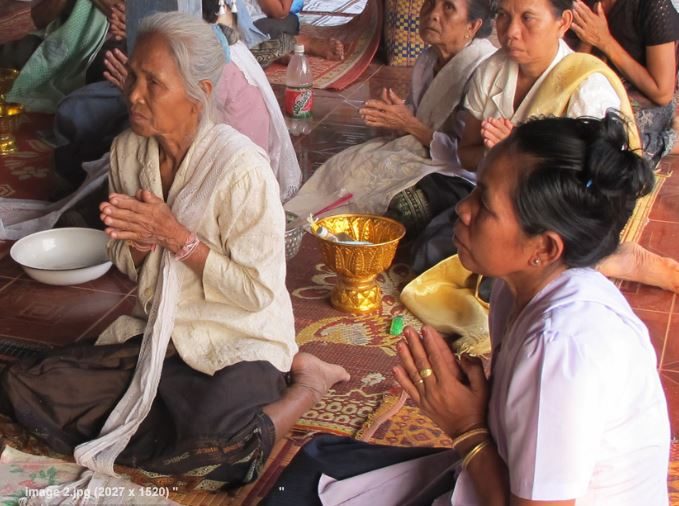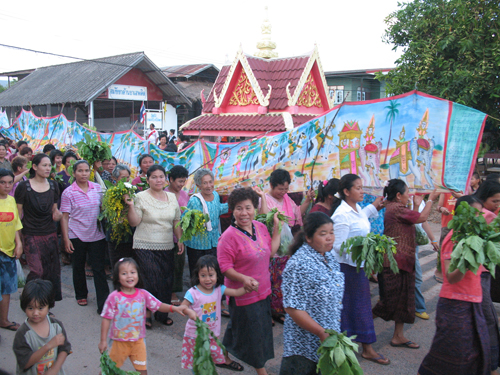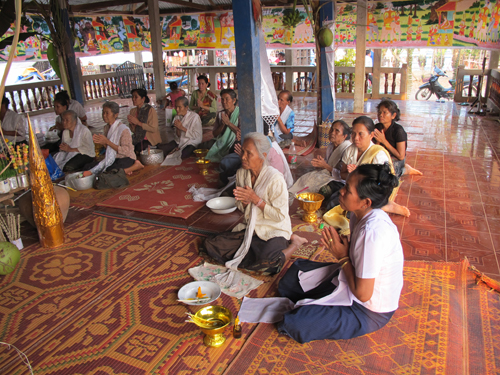Image 1: Scroll procession, Khon Kaen, 2009
This short essay is triggered by Merisa Skulsuthavong’s insightful New Mandala contribution, Suthep’s romantic tale, and some of the comments to it.
Suthep’s invocation of “khondii” to correct the excesses of the current system of Thai government has a long history in the Kingdom of Siam/Thailand and in other Tai cultures generally. At the same time, the most prominent Buddhist story in which this expression appears – the Phra Wetsandaun Chadok, the Vessantara Jataka – and the history of this story in the Kingdom of Siam/Thailand – point out the ambiguous nature of such a “good person” in actual political practice.
According to historians, the latest upsurge of “good men”, phu mii bun, men who came to rectify the problems of the late 19th and early 20th centuries, was roundly condemned by Rama V, King Chulalongkorn. He held that the Kingdom was already governed by “good men”, a hereditary and educated aristocracy of which he and his sons were the rightful heirs. Contemporary historians have said that one way by which King Chulalongkorn addressed the upsurge of phu mii bun was by suppressing popular tellings of the Phra Wetsandaun Chadok and transforming it into a royal ceremony and a test of a young monk’s ability to read Pali.
However, contrarily, we also must be aware that the Vessantara Jataka makes it clear that “good men” do not just appear; their goodness is cultivated prior to their birth and subject to verification by others. Prince Vessantara, Phra Wetsandaun, is born – after 546 previous lifetimes of struggle as well as because he is the son of a monarch and his meritorious wife, the former wife of Indra, King of the Gods – a good person. The crux of the story unfolds after Phra Wetsandaun marries and has two children. He must constantly seek to increase the amount of his goodness – by giving everything away. However, this “goodness” is not understood by the people, who ask their Kingdom’s powerful people to please exile Phra Wet. Only after Phra Wet has gone into exile and, indeed, given away that which was of greatest value – his children and his wife – do the people recognize that, indeed, this is a “good man” who deserves to be invited back to become their ruler. This they do. However, even then ambiguity is present, because, as some people note, how could any truly good person give away his own wife and children?
While Thai in many of the Kingdom’s regions know this story in general terms, probably few have experienced its paradoxes in their lives. By contrast, Thai citizens of Lao ethnicity in the Northeast and elsewhere in Thailand and Lao in neighboring Laos annually participate in the Bun Phra Wet, the Merit-making Festival Celebrating the Life of Prince Vessantara. Congregations for almost every Lao wat associated with a community, Mananikay as well as Thammayut nikaya, numbering perhaps 7,000+ wat with a possible population approaching 30 million, annually celebrate the Bun Pha Wet during the period from February through Songkran. These celebrations are going on now. While a recitation by monks of the complete story takes place, few listen.
The Bun’s most important part occurs the afternoon prior to the recitation, when the people of the community go to a local “forest”, swallow their pride, and community representatives invite Phra Wet to return to their homes, coen Phra Wet khaw nay muang. (Because royalty cannot return to a lowly village, baan, the people decorate their wat with the many objects needed by royalty and redefine their community, for the Bun, as a muang.) The people recognize they have unfairly criticized their rightful ruler and, unrolling a long cloth scroll on which the events of the story are painted, joyfully escort his return. The scroll is mounted in the sala wat, the meeting hall, where it forms the outer boundary of the sacred space in which, on the next day, the monks recite Vessantara’s fulfillment of his goals.
Image 2: Listening to recitation, Champassak, 2010
The impact of this story, shortened here but discussed more thoroughly in the sources below, makes the easy invocation of the concept of khon dii, especially in the context of the Kingdom of Thailand, fraught with problems. The issue is not only whether a khon dii will appear, but also whether he will be recognized. Who has amassed the merit? How is his (the male pronoun is used because, in the Thai context, a male is understood to fulfill this role) merit known? How will such a person be recognized? If he is recognized, what kinds of labors does he have to endure to show he is worthy of the role? Indeed, is his meritorious nature absolutely free of blemish?
Perhaps many Thai recognize the travails of “the good man” or “the good Prince” and have come to see democracy as the most reliable way by which “a satisfactory person” may become a leader for his or her elected time.
Further reading:
สมชาย นิลอาธิ (Somchai Ninlathi) 2537/1994 ผ้าพระเวส ภาพสัญลัษณ์ งานบุญมหาชาติ (Phaa Phra Wet Phaap Sanyalak Ngaan Bun Mahaachaat). สิลปวัฒนธรรม Silapawatthanathaam (Art and Culture) 15(5):88-97
Jory, Patrick 2002a “The Vessantara Jataka, Barami, and the Bodhisatta-Kings: The Origin and Spread of a Premodern Thai Concept of Power.” Crossroads: An Interdisciplinary Journal of Southeast Asian Studies 161(1):152-194
Keyes, Charles F. 1977 “Millennialism, Theravada Buddhism, and Thai Society”. Journal of Asian Studies 36(2):283-302
Lefferts, Leedom, and Sandra Cate 2012a Buddhist Storytelling in Thailand and Laos: The Vessantara Jataka Scroll at the Asian Civilisations Museum. Singapore: Asian Civilisations Museum
2012b “Theravada Buddhism and political engagement among the Thai-Lao of North East Thailand: the Bun Phra Wet ceremony”. South East Asia Research 20(3):329-341
Leedom Lefferts is a retired anthropologist who has worked in Thailand for over 40 years.
 Facebook
Facebook  Twitter
Twitter  Soundcloud
Soundcloud  Youtube
Youtube  Rss
Rss 

